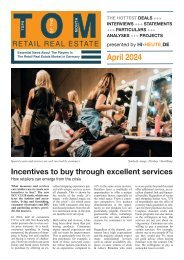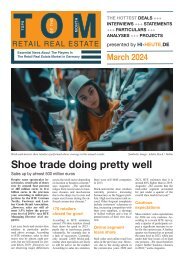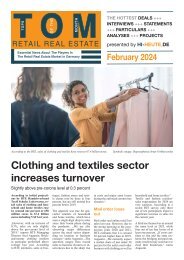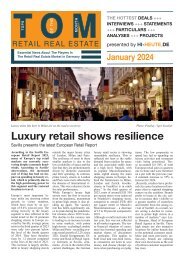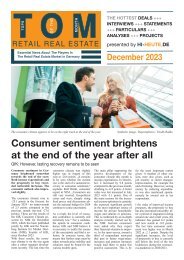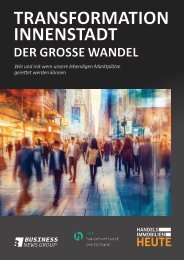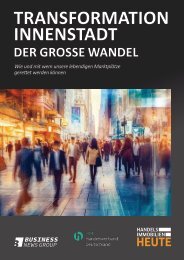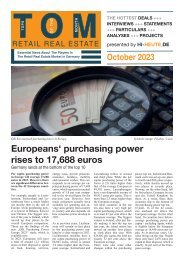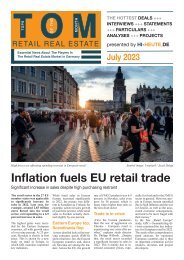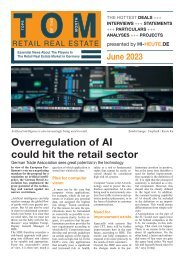TOM June 2020
Create successful ePaper yourself
Turn your PDF publications into a flip-book with our unique Google optimized e-Paper software.
Page 9 T O M<br />
ANALYSES <strong>June</strong> <strong>2020</strong><br />
Frequencies in retail locations<br />
almost at pre-corona level<br />
GfK measurements at the end of <strong>June</strong> give cause for hope<br />
With the spread of COVID-19<br />
in Germany, the number of visitors<br />
to the retail locations in<br />
city centres, shopping centres<br />
and retail parks fell from the<br />
end of February onwards. However,<br />
according to visitor frequency<br />
measurements carried<br />
out by GfK with wetter.com,<br />
the situation has now eased.<br />
The lowest point was reached in<br />
the week following the start of<br />
the nationwide lockdown from<br />
23 to 29 March, when only 41<br />
per cent of the pre-corona frequency<br />
was recorded. Since the<br />
relaxation of measures to contain<br />
the virus, visitor numbers<br />
in all shopping locations are approaching<br />
the levels seen before<br />
the outbreak of the pandemic.<br />
In particular, retail parks are almost<br />
back to pre-corona levels.<br />
Very strong decline<br />
With the start of the lockdown in<br />
the week from 16 to 22 March,<br />
visitor frequency in Germany<br />
declined very sharply in all<br />
shopping locations. This week,<br />
44 percent fewer people visited<br />
retail locations. With the tightening<br />
of contact restrictions, the<br />
frequency in the week from 23<br />
to 29 March even fell 59 percent<br />
below pre-Corona levels. It is<br />
interesting to take a look at the<br />
federal states here: While visits<br />
in Berlin fell most sharply (-63<br />
percent), the decline was least<br />
pronounced in the surrounding<br />
Brandenburg (-45 percent).<br />
„We monitor the number of visitors<br />
to the individual shopping<br />
locations on a daily basis. There<br />
is no question that the corona<br />
virus has had a strong influence<br />
on the shopping behavior<br />
of Germans - and still does,“<br />
comments Filip Vojtech, GfK<br />
expert for retail and fashion &<br />
lifestyle in the geomarketing<br />
sector. „People have been shopping<br />
less frequently and more<br />
cautiously in stationary stores,<br />
especially since the start of the<br />
lockdown, and at the same time<br />
have increasingly shifted their<br />
purchases to online retailing.<br />
The customers have more desire to shop again.<br />
For retailers, this means that<br />
they have to create incentives<br />
through offers, promotions or<br />
the shopping experience in order<br />
to increase visitor frequency<br />
on site again. Above all, however,<br />
the search for highly frequented<br />
and at the same time<br />
target group-specific locations<br />
plays an even more important<br />
role“.<br />
Shopping centers<br />
suffer the most<br />
If we look at the development of<br />
visitor flows broken down into<br />
city centres, shopping centres<br />
and retail parks, a more detailed<br />
picture emerges. Although there<br />
were declines in visitor numbers<br />
in all three shopping locations,<br />
nationwide shopping centres<br />
(-64 percent in the week from<br />
23 to 29 March) and city centre<br />
locations (-59 percent) were<br />
particularly hard hit. In specialty<br />
shopping centers with a local<br />
supply function for the surrounding<br />
area, the frequency in the<br />
same week was 45 percent below<br />
the pre-Corona level.<br />
„One of the reasons why the<br />
number of visitors in city centres<br />
and shopping centres has<br />
fallen so drastically is that these<br />
shopping locations are mainly<br />
occupied by retailers with<br />
goods for medium and longterm<br />
requirements, which had<br />
to close when the lockdown<br />
began,“ says Dr. Hendrik Wagenseil,<br />
GfK expert for Geodata<br />
Science in the Geomarketing division.<br />
„And even in specialist<br />
retail centres, for example, the<br />
textile retailers and DIY stores<br />
that had rented premises there<br />
had to close. Together with the<br />
declining shopping frequency<br />
of the population, this led to less<br />
frequency. At the same time, the<br />
specialty shopping centers have<br />
taken on a central role in the<br />
provision of basic services together<br />
with the local grocery and<br />
drugstore retail trade“.<br />
With the easing of the measures<br />
introduced and the opening of<br />
retail shops under 800 square<br />
metres in the week from 20 to<br />
26 April, the number of visitors<br />
also rose more strongly again.<br />
Nationwide, the retail frequency<br />
increased by 14 percentage<br />
points compared to the previous<br />
week (to 55 percent of the<br />
pre-Corona level). It has been<br />
growing ever since. In the week<br />
from 15 to 21 <strong>June</strong>, visitor frequency<br />
was only 16 percent<br />
below the pre-corona level.<br />
Among the federal states, Berlin<br />
came in last with 27 percent below<br />
pre-corona level that week.<br />
In Mecklenburg-Western Pomerania,<br />
on the other hand, eleven<br />
percent more visitors were measured<br />
at all shopping locations<br />
than at the end of February.<br />
Figures on<br />
the rise again<br />
If you take a closer look at the<br />
three shopping locations individually,<br />
you will see that<br />
the number of visitors to retail<br />
parks in particular has almost<br />
completely recovered. Nationwide,<br />
only seven percent fewer<br />
people were on the move there<br />
in the week from 15 to 21 <strong>June</strong><br />
than before the pandemic; three<br />
weeks earlier the difference was<br />
only four percent. The figures in<br />
German city centres (-16 percent<br />
in the week from 15 to 21<br />
<strong>June</strong>) and shopping centres (-19<br />
percent) are also continuing to<br />
rise and are approaching precorona<br />
levels again - albeit at a<br />
much slower pace.





